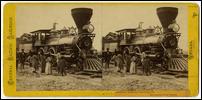Estimated read time: 4-5 minutes
This archived news story is available only for your personal, non-commercial use. Information in the story may be outdated or superseded by additional information. Reading or replaying the story in its archived form does not constitute a republication of the story.
SALT LAKE CITY — The Arizona spike, which was ceremoniously driven in Utah to mark the transcontinental railroad completion in 1869, sold for a little more than $2 million during an auction that closed Thursday, much more than it was expected to reel in.
Christie's listed the spike for auction along with a handful of other historical items. The final sale of $2.22 million far exceeded its pre-auction estimate of $300,000 to $500,000, though it's unclear who purchased the spike.
Peter Klarnet, Christie's vice president and senior Americana specialist, told Artnet News that the sale "soared past our expectations."
"I think the spike captured the imagination of collectors, in part, because it is a potent symbol of national unity," Klarnet told the outlet. "That sense of unity means as much today as it did when the transcontinental railroad was finished less than four years after the Civil War."
So what is the Arizona spike, and how did it come to be?
Most people think of the golden spike when they think of the "Wedding of the Rails" ceremony at Promontory Summit to celebrate the completion of the transcontinental railroad on May 10, 1869. But it was actually one of four ceremonial spikes presented at the event.
Arizona and Nevada each commissioned spikes ahead of the railroad's completion, as did the San Francisco newspaper magnet Frederick Marriott, according to Union Pacific, which compiled a history of the spikes. While Marriott's spike was also gold, Nevada made its spike out of silver and Arizona, then a territory, made its out of iron, gold and silver.
All of the spikes had messages inscribed on them. For example, the Arizona spike reads: "Ribbed with iron, clad in silver and crowned with gold, Arizona presents her offering to the enterprise that has banded a continent, dictated a pathway to commerce. Presented by Governor Safford."
After the ceremony ended, all four spikes ended up going to the event's different distinguished guests. David Hewes, the brother-in-law of Central Pacific Railroad President Leland Stanford, commissioned the famed golden spike and took it back with him to California. The National Park Service notes that Hewes eventually donated it to Stanford University's art museum in 1892, where it remains today.
The Nevada spike was presented to Stanford and also ended up going to the university.
Marriott's golden spike from San Francisco, which wasn't the same quality as Hewes' spike, eventually "faded into obscurity," Union Pacific historians wrote. It was believed to have been given to one of Union Pacific's executives but it's unclear what happened to it. Historians acknowledge that Marriott's spike could have been destroyed in the 1906 earthquake and fire; either way, that spike's fate remains a mystery.
The fate of the Arizona spike was also unknown for quite some time. It emerged in 1943 when a descendent of Sidney Dillon, a Union Pacific executive at the time the railroad was completed, donated it to the Museum of the City of New York, according to Christie's. It was loaned to several museums beginning in 1978 up until last week's auction.
The spike even briefly returned to Utah four years ago ahead of the state celebration marking the 150th anniversary of the railroad completion. It joined the golden spike and Nevada spike at the Utah Museum of Fine Arts — the first time all three were in Utah at the same time since the 1869 ceremony.
While one of the four spikes was lost in time, another has since emerged. Utah leaders also commissioned a copper spike in 2019 to commemorate the sesquicentennial anniversary. Then-Utah Gov. Gary Herbert said the spike was meant to honor Utah's "significant role" in the railroad's history.
"I think we forget the magnitude and the significance of this event," he said at the time. "What it represents is, we can do hard things during difficult times. We can dream big, work hard and if we work together, there's no limit to what we can accomplish."
More on the railroad completion











